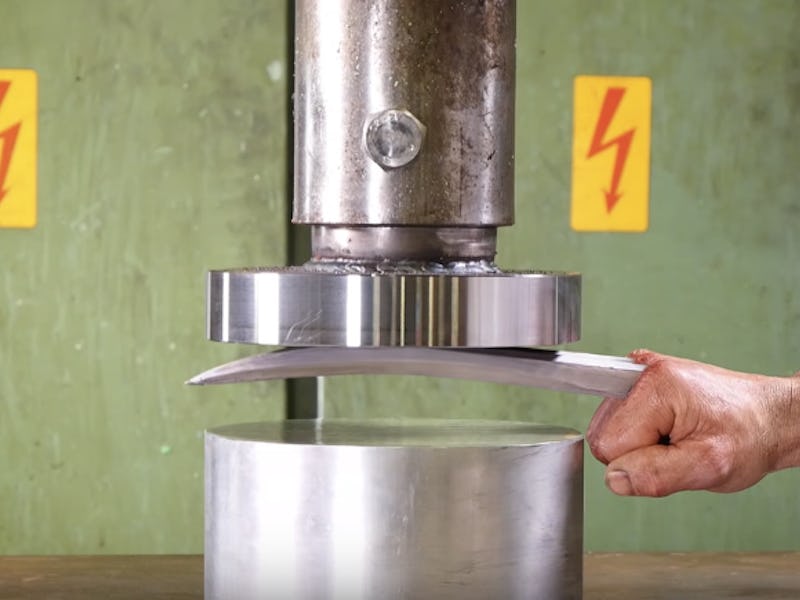In a new commercial for the upcoming Wolverine film Logan, a pair of “adamantium” claws are thrust beneath the crushing jaws of a hydraulic press. “Holy fawking sheet!” Lauri Vuohensilta, the Finnish genius behind YouTube’s Hydraulic Press Channel, exclaims as the claws slice through the steel press of the base. Holy fawking sheet indeed: Adamantium is a fictional metal, so whatever alloy these claws are actually made out of is really fucking strong.
Let’s assume, for now, that Vuohensilta is not lying about the parameters of his experiment. In the video, he says that the cylinder beneath the press is made of hardened steel, and the pressure he applies during the first phase of the experiment — in which he tries to crush an adamantium sphere — starts at 150 bars (the metric unit for measuring pressure) then gets cranked up to 300 bars. In the Marvel universe, adamantium is said to be a dark gray iron-based alloy that’s virtually indestructible and can cut through pretty much anything if it’s filed to a sharp enough point. For the claws in the video to cut through a block of hardened steel like butter, they’d likely have to be made of one of three known metals.
They could be made of titanium, which, in its pure form, has the highest strength-to-density ratio of any of the metallic elements (that is, it’s super strong and super light). It’s not always as hard as some types of heat-treated steel (which is, itself, a mixture of carbon and iron), but that can be remedied by blending it together with other metals like iron, aluminum, and vanadium. It isn’t easy to cut — people with titanium watches sometimes run into issues cutting links — but it can be done using heat, high pressure, and steel blades tipped with a carbide, compound made up of the element tungsten.
Seriously.
Tungsten is another very hard element that could withstand steel in its purest form. As far as pure metals go, it’s the most resistant to melting, and it has the highest “tensile strength,” which means it can withstand more force (pulling, heavy weight) before its breaking point than any other metal. It’s most often blended together with carbon to make carbide, which is used to coat the blades of instruments used to cut other very strong metals.
Pure metals aside, there’s a superalloy known as inconel, which is made by melting together nickel, chromium, and austenite (a bizarre form of iron in which it exists as a solid solution with another element), that might also withstand the force of hydraulic press. It’s especially stable over a wide range of temperatures (other metals like aluminum or steel tend to get weaker when conditions get really hot) and is great at withstanding high pressures, which is probably why it’s used in “extreme” environments like nuclear reactors and rocket engines.
Of course, there are new alloys being developed each year — often alloys involving the metals above — that are said to be stronger than steel. Because they’re so new, however, it’s unlikely that Vuohensilta and the Logan marketing team managed to get their hands on any of them — or even, for that matter, enough inconel or pure titanium or tungsten to smash up for the purposes of this video. The much more probable scenario is that Vuohensilta isn’t being entirely truthful about the nature of his hydraulic press base, and it’s actually made up of a softer metal alloy (probably steel) than the claws used in the video.
Still, despite the dubious veracity of this experiment, Vuohensilta is not lying when he says “Holy shit, that was intense.” Check out the steel-slicing action of the mystery metal below.
